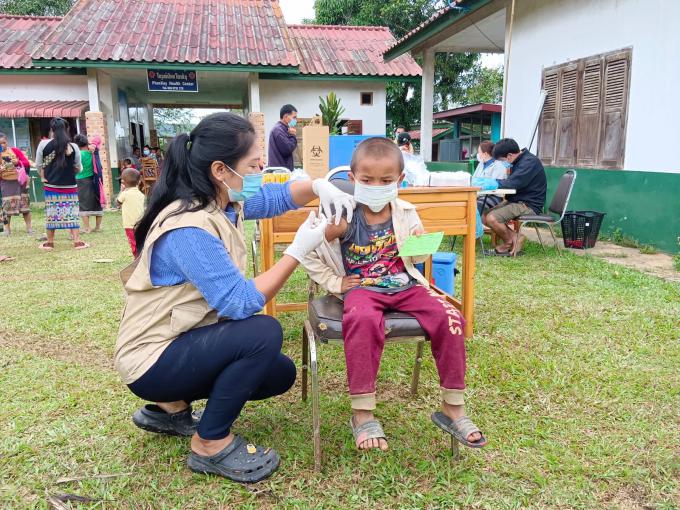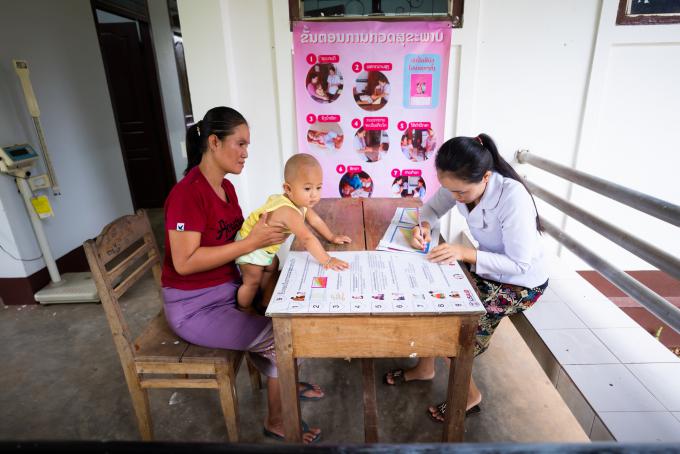Health and Nutrition
Save the Children International in Laos is dedicated to ensuring that every child thrives in an environment that safeguards them from preventable health risks, allowing them to grow and develop successfully. Our life cycle approach focuses on the well-being of both children and mothers, addressing key challenges and catalyzing positive change in healthcare practices.
According to Basic Statics 2023, Lao PDR was among eight contries in Asia and the Pacific recorded under-5 mortality rate (death per 1,00 live births) exceeding the global estimate of 38.1 in 2021. Notably, Laos (43 per 1,000 live births), along with serveral other regional countries, continue to experience alarming high rates of under-5 mortality.
The prevalence of chronic undernutrition, known as stunting, remains significant in the Lao PDR, where approximately one-third of children under the age of five are affected. Additionally, around 21% of children in this age group are underweight, while 9% are wasted. Undernutrition disproportionately impacts marginalized groups such as the impoverished, ethnic minorities, and those living in rural and upland regions.
What We Do
Global Leadership in Newborn Health:
Save the Children is a global leader in newborn health and survival, advocating for evidence-based interventions to address the major causes of neonatal mortality: prematurity, birth asphyxia, and infections. In Laos, our commitment extends to strengthening healthcare capacities, preventing maternal and child mortality, and tackling malnutrition.
Maternal and Child Health:
Save the Children prioritizes improving maternal and child health outcomes through comprehensive initiatives. We provide access to quality healthcare services, antenatal and postnatal care, essential immunizations, and advocate for safe hygiene practices. Our efforts aim to reduce mortality rates by training healthcare providers and promoting nutrition for pregnant women and new mothers.

Addressing Malnutrition:
To combat malnutrition, we deliver nutrition education, establish community-based nutrition programs, and encourage breastfeeding and appropriate complementary feeding practices. Our collaboration with local partners focuses on tackling undernutrition and stunting, aiming for healthier outcomes for both children and mothers.
Water, Sanitation, and Hygiene (WASH):
Save the Children emphasizes the improvement of WASH practices in communities and schools. Ensuring access to clean water, proper sanitation facilities, and promoting hygiene practices such as handwashing contribute significantly to reducing waterborne diseases and enhancing overall health outcomes.
Health Education and Community Engagement:
Our health education programs raise awareness about various health issues, providing communities with knowledge and skills for healthier lives. We emphasize disease prevention, proper nutrition, hygiene practices, and family planning. Training healthcare workers and volunteers further enhances community health initiatives.
Strengthening Health Systems:
Actively collaborating with local authorities, community leaders, and stakeholders, we work towards strengthening health systems, policies, and service delivery. Advocacy efforts aim to increase investment in health and nutrition programs, engaging in policy dialogue for better healthcare access.
Dengue Prevention and Control:
Save the Children conducts awareness campaigns to educate communities about Dengue fever. Engaging community members, schools, and local leaders, we promote knowledge about Dengue transmission and prevention strategies. We actively participate in advocacy efforts to prioritize resources for Dengue prevention and control measures.

Our Impact
During 1 year period from Jan. to December 2023, there were 2,502 people trained from: specialist doctors, ethnic students on nursing scholarships, to nurses becoming qualified as midwives, health staff managing local souksalas (clinics), to village volunteers responding to the dengue epidemic.
In 2023, a significant number of beneficiaries, including 36,726 women and 42,939 children, were reached by the health project. This initiative encompassed various programs such as Maternal, Infant, and Young Child Nutrition projects alongside Other Health and Nutrition Interventions. The collective impact of these efforts aimed to address the diverse health needs of women and children, contributing to enhanced well-being and fostering a healthier community overall.
Future Directions
Acknowledging gaps in health service coverage, our future focus involves working with diverse stakeholders to reach the unreached. Strengthening health systems, adopting integrated approaches, empowering communities, and leveraging technology and innovation are key components of our vision for the future. Save the Children International in Laos remains committed to pioneering solutions that improve health outcomes and create lasting impact.
 Laos
Laos